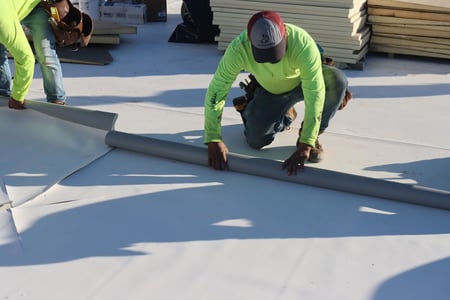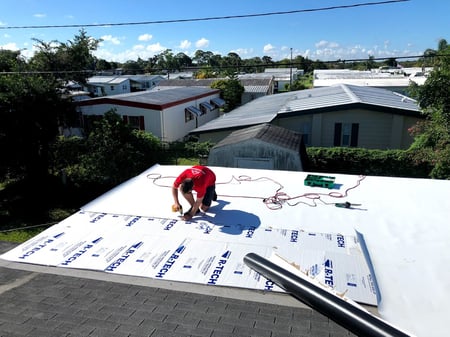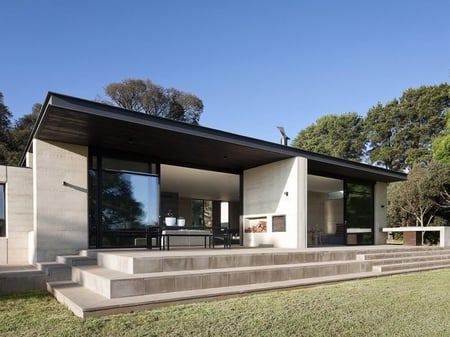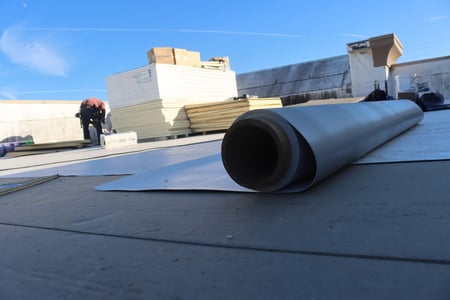What Is Rolled Roofing?
October , 2023 | 7 min. read

Rolled roofing is a versatile roofing material that has found its place in both residential and commercial construction. Known for its simplicity and cost-effectiveness, rolled roofing offers a practical solution for roofs with low slopes or nearly flat designs. Plus, when you choose rolled roofing, due to the ease of installation, your project time will likely shorten!
As much as we love hanging out on your roof, we understand that you’d rather us be elsewhere with our hammers and drills. Unless you like the noise, we don’t judge. RoofCrafters enjoys using rolled roofing not only because of the top-notch materials and durability that we’re able to provide you with but also because it allows us to get out of your hair a bit quicker than usual, and let you get back to your quiet and peaceful daily routine.
So, whether you're considering a budget-friendly solution for a small residential structure or seeking an option for a low-slope commercial building, rolled roofing may offer the answers you're looking for. That being said, in just a few short moments, you’ll learn what rolled roofing is, what types of structures use it, and the ways it can be used in both residential and commercial roofing. Let’s jump right in!
What Is Rolled Roofing?
Rolled roofing is a type of roofing material that is commonly used for low-slope or flat roofs on residential and commercial buildings. It is also sometimes referred to as "roll roofing" or "roll-out roofing." Rolled roofing is typically made from similar materials such as asphalt shingles but comes in a roll form, which makes it easier to install on roofs with minimal slope.
.png?width=778&height=130&name=Recommended%20Reading%20(22).png)
Some key characteristics and features of rolled roofing include:
Material: Rolled roofing is primarily made from asphalt-integrated felt or fiberglass mats. This material is coated with asphalt or a modified bitumen that provides waterproofing and weather resistance.
Roll Form: Rolled roofing is manufactured in rolls, typically 36 inches wide and around 33 feet long. The rolls are lightweight and easy to transport, making them convenient for installation.
Installation: Rolled roofing is relatively easy to install compared to traditional asphalt shingles. It is typically applied by unrolling the material onto the roof surface and then securing it in place with roofing nails or adhesive. Overlapping seams are sealed with roofing cement or asphalt-based adhesive to ensure a watertight seal.

Types: There are a few different types of rolled roofing, including plain roll roofing and mineral-surfaced roll roofing. Mineral-surfaced roll roofing has granules embedded on the surface, providing additional durability and UV protection.
Durability: Rolled roofing is not as durable as some other roofing materials, such as asphalt shingles or metal roofing. It is more susceptible to damage from the elements, especially in areas with extreme weather conditions.
Lifespan: The lifespan of rolled roofing can vary depending on the quality of the material and the climate in which it is installed. In general, it tends to have a shorter lifespan compared to other roofing materials, typically lasting 5 to 12 years or more, depending on the specific product and maintenance.
Cost: Rolled roofing is one of the most cost-effective roofing materials available, making it a popular choice for budget-conscious homeowners or use on outbuildings like sheds and garages.
What Types of Buildings Use Rolled Roofing?
Rolled roofing is typically best suited for specific types of roofs and situations, primarily those with low slopes or nearly flat pitches.
.png?width=1200&height=200&name=Recommended%20Reading%20(23).png)
It's a cost-effective roofing material that can be a good fit for the following types of roofs:
Flat Roofs: Rolled roofing is commonly used on flat roofs or roofs with a very low slope. Its ease of installation and ability to create a waterproof barrier makes it a practical choice for such roof designs.

Shed Roofs: Rolled roofing is often used for small structures like garden sheds, playhouses, or workshops with simple roof designs. It provides an economical and functional roofing solution for these applications.
Porches and Canopies: Rolled roofing can be used to cover open porches, patios, or canopies where the roof has a minimal slope. It can protect these areas from the elements and extend their lifespan.

Temporary Structures: Rolled roofing can be suitable for temporary or short-term structures like construction site offices, storage sheds, or event tents. It offers a quick and affordable way to create a weather-resistant roof.
Budget-Friendly Projects: Due to its affordability, rolled roofing is often chosen for projects with limited budgets, where a more durable or aesthetic roofing material is not required.
However, rolled roofing may not be the best choice for roofs with steeper slopes or those in areas with extreme weather conditions. Its relatively short lifespan and susceptibility to damage from UV rays and harsh weather make it less suitable for long-term or high-impact applications. In such cases, homeowners might opt for more durable roofing materials like asphalt shingles, metal roofing, or built-up roofing systems, depending on the specific requirements and budget constraints.
Is Rolled Roofing Best Suited for Residential or Commercial Roofing?

Rolled roofing is used in both commercial and residential roofing applications, but it is more commonly associated with residential roofing, particularly for small-scale and budget-conscious projects. Here's a breakdown of its usage in both sectors:
Residential Roofing
- Rolled roofing is often used on residential structures like small houses, garages, sheds, and outbuildings with low-slope or flat roofs.
- Homeowners sometimes choose rolled roofing when they need an affordable and relatively quick roofing solution for a small area.
- It's commonly used for porches, carports, and other residential structures with low-slope roofs.
Commercial Roofing
- Rolled roofing is also utilized in commercial roofing, especially for low-slope or flat-roofed commercial buildings.
- It may be chosen for small commercial structures, storage facilities, or industrial buildings where cost-effectiveness is a primary consideration.
- In some cases, commercial building owners or contractors may opt for modified bitumen rolled roofing, which offers enhanced durability and weather resistance compared to standard rolled roofing.
While rolled roofing is more prevalent in residential settings, its use in commercial roofing depends on the specific requirements of the project and the budget constraints. In both cases, proper installation and maintenance are crucial to ensuring the longevity and effectiveness of the roofing system.
Get the Ball Rolling With Rolled Roofing
As you now know, rolled roofing is a roofing material primarily used for low-slope or flat roofs in both residential and commercial applications. It is characterized by its affordability, ease of installation, and suitability for small-scale projects or structures with minimal slope. Rolled roofing provides a cost-effective way to create a waterproof barrier and protect roofs from the elements.
While rolled roofing has its advantages, such as being budget-friendly and relatively easy to install, it also has limitations. Its lifespan is shorter compared to some other roofing materials, and it may not withstand extreme weather conditions or provide the same level of durability. Therefore, it is often chosen for temporary structures, outbuildings, or projects with budget constraints.
The choice to use rolled roofing should be based on the specific needs of the project, the roof's slope, and the local climate. Proper installation and maintenance are essential to maximize its lifespan and effectiveness. For larger or more demanding roofing projects, alternative materials with greater durability and longevity may be more suitable. If you’re interested in rolled roofing for your next roofing project, or interested in learning more about the other options available to you, be sure to hit the “Schedule an Inspection” button, and one of our experts will break down the process for you!
My name is Cassie, and I’m the Content Manager here at RoofCrafters. I was born and raised in Chicago, Illinois, and made my way out to Florida post-college graduation. I’m incredibly passionate about writing and creating valuable content that helps others with the collaboration of my marketing team. When I’m not working, I enjoy shopping (a little too much), spending time at the beach, and reading!



